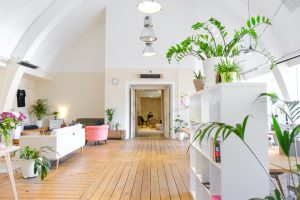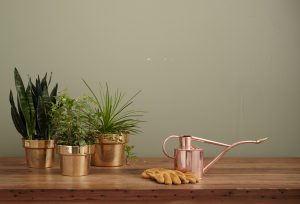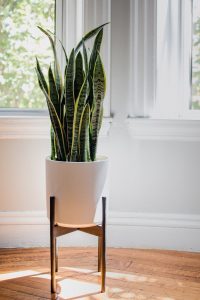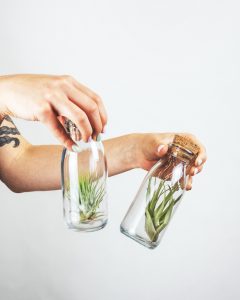BLOGS
Low Maintenance Plants for your Luxury Condominium
To all the aspiring Plantitas and Plantitos out there, this article is for you. Nowadays, it is important to take on healthy and meaningful habits that contribute to homeowners’ mental health, especially when they are working from home and spending almost every minute of life indoors. And what better way to bring in the beauty of the outdoors than creating your own living sanctuary indoors through low maintenance plants in your luxury condominium?

Elevate your space with plants | Photo by CoWomen on Unsplash
Benefits of Growing Low Maintenance Plants at Your Luxury Condominium
Plants have tons of benefits for every Brittany Corporation luxury home. And If you live with your loved ones, it can also be a great bonding activity with children or a way for a newly wed couple to take care of something easy before embarking on the journey of parenthood. Here are a few benefits that are already worth buying a bunch of them.
1. They naturally filter out and clean the air, which is essential considering the pandemic that we are experiencing right now. Plants are able to absorb toxins, increase humidity, and produce oxygen through the process of photosynthesis. Some are even capable of repelling mosquitoes, specifically the citronella plant, which can be easily grown and then ground to extract the mosquito repelling oils from its leaves.
2. Studies show that low maintenance plants are proven to increase productivity and lessen stress; hence greatly contributing to the homeowner’s mental wellbeing. Moreover, being surrounded by plants helps people feel more calm and relaxed, thus decreasing levels of anxiety. No wonder it is also considered a best practice for employers to install indoor low maintenance plants around their offices and working spaces.
3. Finally, they add beauty to every space, whether that be tiny offices or mansions in the Philippines. Adding living aesthetically pleasing ornamental plants to a room can improve a homeowner’s moods the same way a beautiful painting could light up a whole house and lot. Adding living greenery in a dull spot can truly change the whole mood. Plants remind us that we can be both growing yet beautiful, perfectly still yet helpful.
These are just some general benefits common to most plants, yet with the variety of plants in the world, each plant has its own benefit and some may even pose risks. For example, if you are living with a pet cat or dog, it is imperative that you check first if the plant that you are bringing to your Brittany Corporation luxury home is safe for your furry friends. The plants themselves may be greatly beneficial to you, but are not meant to be ingested at all. To be safe, as with all things, always do your research before buying anything.
Suggested Read: 6 Ways to Celebrate the Holidays When You’re Living Alone | Brittany

Maintaining your plants doesn’t have to be an arduous task. You just need to find the right plants for your home. | Photo by Kaufmann Mercantile on Unsplash
Low Maintenance Plants You Should Start Growing in Your Luxury Home by Brittany Corporation
Before becoming true green thumbs, however, every hobbyist must first cover the basics. After all, you most likely won’t be able to grow healthy delicate plants such as roses and orchids, even if you lived in the most expensive houses in the Philippines, if you don’t know how to properly take care of low maintenance plants featured in this article.
Succulents are for the Lazy
Succulents are a type of plant with thick fleshy tissues adapted to water storage. This means that they can store water for longer periods of time in order to withstand hotter temperatures. A famous example of succulent plants is the cactus, which is famous for its ability to thrive in the desert. This means that these low maintenance plants thrive with neglect, which is perfect if you want to check in on your plant only once a week or two.
Aloe Vera (Aloe barbadensis miller)
The Aloe Vera is a succulent plant known for its plump leaves that can provide a soothing gel for cuts and burns. They also make for great hair masks and face masks, evidently with all the aloe vera based body care products available in the market. Once the leaves are big enough, you can harvest its goodness by plucking out a leaf, peeling it, and pouring the cool gel to a pot for your personal use.
If you want to care for an Aloe Vera, allow the soil to dry out completely in between waterings. Depending on the humidity of your home, that may mean watering as little as every two to three weeks. The average height of the Aloe Vera is two feet, but they can grow up to three feet tall. However, if you want to save on space, you can also choose to grow miniature ones by placing them in smaller two to three inch pots.
If you want to propagate your Aloe Vera, just gently pull out some offsets from the mother plant’s roots. Offsets, also called pups or offshoots, are clones that grow from the stem or roots of the parent plant. Place them in well drained soil where they can grow on their own. Don’t plant them deep into the soil in order for the roots to breathe and heal from the damage, and then just let them dry for a week before you start watering them. In no time, you will have a whole corner of Aloe Vera plants!

The Snake Plant | Photo by Kelly Sikkema on Unsplash
Snake Plant (Sansevieria trifasciata)
Snake plants might just be the most common low maintenance plant for condo homes as well as offices.This is because they are even easier to take care of than other succulent plants like the Aloe Vera. In fact, this mighty plant can even survive weeks without sunlight or water and still look good as new. With this in mind, maybe beauty brands should be focused on trying to discover the Snake Plant’s secrets instead. This alone should be a good enough reason to purchase plants now if you are a lazy aspiring Plantita/Plantito. They are best with medium to bright light and a sprinkle of water when the soil dries out.
If you are wondering about the origins of its name, just check the patterns on its long pointed leaves. They are greens with a pattern reminiscent of a snake’s scaly exterior. These thick and stiff leaves grow up to three feet long. Overtime, the leaves can overcrowd a pot but no worries because you can just repot the other leaves. If you want to propagate some more of these plants, there are two ways: the water method and the soil method. If you want to experiment, you can do both at the same time! Simply cut the leaves of your snake plant but keep the rooted ones in place to grow. Then, place half of the end parts in a new pot, standing on the surface of the soil. Place the bottom of the other half of the end parts in a cup of water and replace the water every couple of days. Soon, you will see tiny roots growing in both batches. Voila!
Jade Plant (Crassula ovata)
The Jade Plant is a crowd favorite because of its adorable jelly bean looking leaves. They stay this way when you keep them in small pots. However, once they grow a few feet taller in bigger pots, the jelly beans start looking like stubby fingers. Since their leaves are thicker than their stems, it goes without saying that this plant can go out of balance if potted in a weak container. Since the top half of the plant is heavier than its base, make sure to use a heavier pot to support the entire plant, such as terracotta pots.
To take care of this low maintenance plant, simply make sure that the soil is completely dry before watering again. It is easy to observe when the Jade Plant is stressed because the leaves can fall out yet grow back easily. They can generally grow in any environment with medium to high sun exposure.
If you want to avoid growing your Jade Plant too heavy, you can simply cut the stems at three to four inches long for propagation. But before this, you must first make sure that the mother plant is completely dry before cutting. Let the cutting rest in a dry, preferably warm, spot until a callus develops in about one to two weeks. Once the cut on the jade plant cutting has dried, place the cutting into a potting mixture made of half vermiculite or perlite and half soil. Vermiculite or perlite are small pebbles usually used to decorate succulents and are fairly easy to find in the country, so no worries about that. When rooting a jade plant, water sparingly so that the potting mixture is only damp until the jade plant cutting takes root. After it has rooted, you can treat it as you would a normal jade plant.
Non-Succulent Plants that are still easy to take care of
The plants listed in this section are low maintenance plants that need a little more maintenance compared to succulent plants.
Photos Plant or Devil’s Ivy (Epipremnum aureum)
The Photos is probably the most common non-succulent low maintenance plants, especially in tropical countries; so much so that you can even find them in the jungle while hiking in the Philippines because it is a tropical vine. They can practically grow anywhere in the tropics and are pest and disease free. They also thrive in neglect similar to the succulents mentioned above and are a good choice even for darker areas of the luxury condominium.
The great thing about the Photos is its versatility. It can be potted traditionally, hung as an aerial plant, or dangling as a vine. Moreover, it also doubles as an air purifier that you don’t have to stress about compared to other more demanding plants. It’s the gift that keeps on giving, so it is also sweet to gift this to friends and family members who want to start taking care of low maintenance plants as a hobby this holiday season. However, if they have pets in their luxury homes, make sure to keep the plant out of their reach because it can be poisonous when ingested.
To propagate, cut full grown stems six inches long just below a leaf node and place in water. Change the water every two to three weeks and roots will develop over a month or two. Once enough roots have grown, repot the plant in fresh soil.

Air plants can be stored in many ways, just like air! | Photo by Severin Candrian on Unsplash
Air Plants (Tillandsia spp.)
Air plants are the cute puff balls in the plant kingdom. They are great for space saving in luxury condominiums but are also a great addition when interior designing mansions in the Philippines. They can be fascinating because not only can they survive by just floating in the air without soil, but they can also have alien features given that there are hundreds of species and variations of the Air Plant. This is definitely for homeowners who want a more modern touch to their living space. So how do they grow in air? These low maintenance plants are actually epiphytes, meaning that in nature they grow on other plants, usually on tree branches. But they do well on their own and actually even flower.
A good tip when buying Air Plants is to buy the ones with silvery leaves. This is because the greener leaves tend to dry out faster and the silver ones tend to need much less water and maintenance. They love a humid environment and can freely grow in areas with frequent rains. In your luxury condominium, however, you will have to water them thoroughly every week or two. To do this, place them in the sink or a small jar with enough liquid to submerge your plants. Let them soak for about half an hour, then give them a gentle shake to get rid of some water before turning them upside down on a towel to let them drain. Once they are dry, return them to their designated spot. In particularly dry times, you can mist them with water every day in between soaks. In terms of light, they prefer well lit environments but never direct sun exposure. Remember that they thrive in humid conditions instead of dry ones.
Brittany Corporation: The Perfect Home for your Plants
If you are looking to move to a grander space where you can grow your family as well as your plants, checkout Brittany Corporation’s roster of properties in key locations surrounding the metro South: Vista Alabang, Brittany Sta. Rosa in Laguna, La Posada in Sucat, and Crosswinds Tagaytay. Each beautiful in their thematic appeal, you will find that every Brittany home is embraced by nature. Enjoy a blissful life in the perfect havens surrounding the city.

A campaign ad for Lausanne, a residential space at Crosswinds Tagaytay.
Visit Brittany’s official property page to know more about Brittany’s beautiful thematic offerings or follow us on our Linkedin, Facebook, Twitter, and Instagram accounts!
For those who are interested in being a seller for Brittany, visit our E-Suite seller’s portal here.
Concerns about your home? Click on our Vista Land Homeowner’s Portal.

















